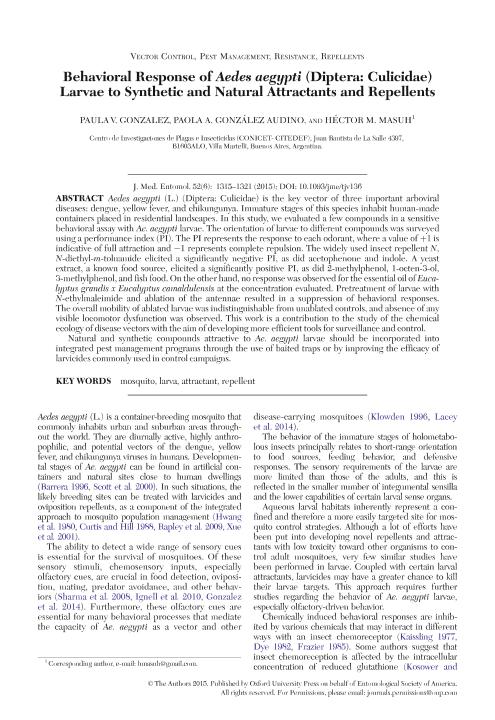Artículo
Behavioral Response of Aedes aegypti (Diptera: Culicidae) Larvae to Synthetic and Natural Attractants and Repellents
Fecha de publicación:
09/2015
Editorial:
Entomological Society of America
Revista:
Journal of Medical Entomology
ISSN:
0022-2585
Idioma:
Inglés
Tipo de recurso:
Artículo publicado
Clasificación temática:
Resumen
Aedes aegypti (L.) (Diptera: Culicidae) is the key vector of three important arboviral diseases: dengue, yellow fever, and chikungunya. Immature stages of this species inhabit human-made containers placed in residential landscapes. In this study, we evaluated a few compounds in a sensitive behavioral assay with Ae. aegypti larvae. The orientation of larvae to different compounds was surveyed using a performance index (PI). The PI represents the response to each odorant, where a value of + 1 is indicative of full attraction and -1 represents complete repulsion. The widely used insect repellent N, N-diethyl-m-toluamide elicited a significantly negative PI, as did acetophenone and indole. A yeast extract, a known food source, elicited a significantly positive PI, as did 2-methylphenol, 1-octen-3-ol, 3-methylphenol, and fish food. On the other hand, no response was observed for the essential oil of Eucalyptus grandis x Eucalyptus camaldulensis at the concentration evaluated. Pretreatment of larvae with N-ethylmaleimide and ablation of the antennae resulted in a suppression of behavioral responses. The overall mobility of ablated larvae was indistinguishable from unablated controls, and absence of any visible locomotor dysfunction was observed. This work is a contribution to the study of the chemical ecology of disease vectors with the aim of developing more efficient tools for surveillance and control. Natural and synthetic compounds attractive to Ae. aegypti larvae should be incorporated into integrated pest management programs through the use of baited traps or by improving the efficacy of larvicides commonly used in control campaigns.
Palabras clave:
Mosquito
,
Larva
,
Attractant
,
Repellent
Archivos asociados
Licencia
Identificadores
Colecciones
Articulos(UNIDEF)
Articulos de UNIDAD DE INVESTIGACION Y DESARROLLO ESTRATEGICOS PARA LA DEFENSA
Articulos de UNIDAD DE INVESTIGACION Y DESARROLLO ESTRATEGICOS PARA LA DEFENSA
Citación
Gonzalez, Paula Valeria; Gonzalez Audino, Paola Andrea; Masuh, Hector Mario; Behavioral Response of Aedes aegypti (Diptera: Culicidae) Larvae to Synthetic and Natural Attractants and Repellents; Entomological Society of America; Journal of Medical Entomology; 52; 6; 9-2015; 1315-1321
Compartir
Altmétricas




